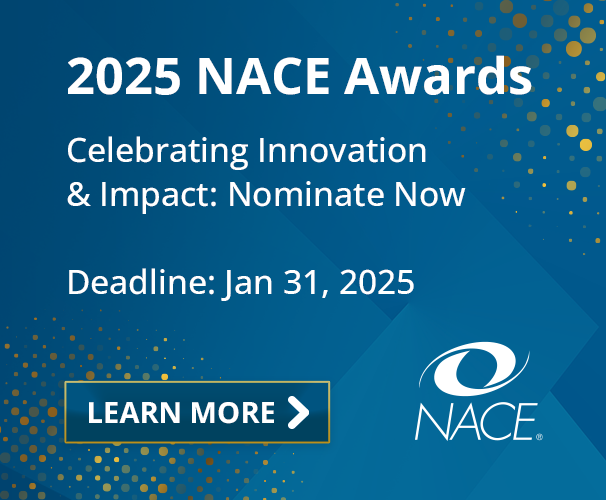NACE Journal, November 2016
Using data from NACE’s 2016 Student Survey, NACE research looks at factors that may influence the job success of first-generation students.
First-generation students and their post-graduate transition represent a significant issue for higher education leaders in general and career services professionals in particular, making research into their attitudes, behaviors, and outcomes critical.
Previous studies conducted outside of NACE have shown first-generation students are more likely to begin college at two-year institutions, dimming the probability of advancing to and graduating from a bachelor’s program (Engle, 2007). Data from NACE’s 2016 Student Survey concur with this statement. However, first-generation students do make up a substantial portion of four-year enrollments. Among four-year students responding to the survey, 40 percent self-identified as first generation. Similarly, among responding Class of 2016 bachelor’s degree graduates, 41.2 percent self-identified as first generation. (See Figure 1.) This surpasses previous graduation rates of both low-income first-generation students (10.9 percent) and first-generation students not of low income (24.9 percent) (Wine, Wheeless, 2011). This suggests a trend toward first-generation students accounting for a larger share of four-year enrollments.
Figure 1: Student Body Breakdown by Program Enrollment
Among respondents to NACE’s 2016 Student Survey, 5,013 graduating seniors self-identified as being either first generation (1,925) or non-first generation (3,088). First-generation students are defined as those having a parent/parents that does/do not possess a bachelor’s degree.
In this sample, first-generation and non-first-generation students are similar when looking at gender, the majority of students being female (taken together, they averaged 72.3 percent female, 27.8 percent male). This separation by gender is also the case for students entering the work force (averaging 68.8 percent female, 31.3 percent male).
A significantly larger percentage of first-generation students are 25 years of age or older (19.9 percent) compared to non-first-generation students (7.8 percent), showing a delay in student-program enrollment. Racial diversity is larger among first-generation students as well, especially among the older, nontraditional aged students. (See Figure 2.)
Figure 2: Racial Diversity Among Graduating Seniors
Choice of Major: First-Generation and Non-First-Generation Students
To investigate differences in career choice, areas of study were separated into two categories: career-oriented majors and academic majors. Career-oriented majors are those that prepare students for a specific occupational area and include business, education, health/nursing, engineering, computer science, and a “career-oriented: other” category, which includes career-oriented majors with too few respondents to analyze separately. Academic majors are not tailored toward a specific occupational field. These majors include social/behavioral sciences, liberal arts, science, mathematics, and an “academic: other category” (Choy, Bradburn, 2008).
Among respondent, slightly fewer first-generation seniors were enrolled in a career-oriented major (48.7 percent) in comparison to non-first-generation seniors (50.9 percent). In general, the breakdown of majors was similar between first generation and non-first generation. (See Table 1.) However, there was significant divergence in two majors—engineering and social/behavioral sciences. There were twice as many non-first-generation engineering majors as there were first-generation students undertaking this field (9.9 percent vs 4.7 percent), while there were first-generation social/behavioral science majors than non-first-generation students in this field (19.8 percent vs. 15.0 percent). As NACE’s annual Student Survey has consistently shown that career-oriented majors tend to secure jobs earlier and out-earn academic majors—at least at the outset of the career—one could posit that first-generation students either do not recognize this dynamic or are not focused on it.
Table 1: Student Enrollment in Career-Oriented and Academic-Oriented Majors
| Business | |
|---|---|
| Education | |
| First Generation | 108 |
| Non-First Generation | 5.6% |
| 156 | |
| 5.1% | |
| Healthcare/Nursing | |
| First Generation | 173 |
| Non-First Generation | 9.0% |
| 282 | |
| 9.2% | |
| Engineering | |
| First Generation | 90 |
| Non-First Generation | 4.7% |
| 304 | |
| 9.9% | |
| Computer Science | |
| First Generation | 42 |
| Non-First Generation | 2.2% |
| 97 | |
| 3.2% | |
| Career-oriented, other* | |
| First Generation | 137 |
| Non-First Generation | 7.2% |
| 160 | |
| 5.2% | |
| Social/Behavioral Sciences | |
| First Generation | 379 |
| Non-First Generation | 19.8% |
| 460 | |
| 15.0% | |
| Liberal Arts** | |
| First Generation | 267 |
| Non-First Generation | 14.0% |
| 474 | |
| 15.4% | |
| Science | |
| First Generation | 217 |
| Non-First Generation | 11.3% |
| 364 | |
| 11.8% | |
| Mathematics | |
| First Generation | 18 |
| Non-First Generation | 0.9% |
| 43 | |
| 1.4% | |
| Academic, other*** | |
| First Generation | 99 |
| Non-First Generation | 5.2% |
| 169 | |
| 5.5% | |
| First Generation | Non-First Generation | |||
|---|---|---|---|---|
| N | % | N | % | |
| Business | 382 | 20.0% | 566 | 18.4% |
| Education | 108 | 5.6% | 156 | 5.1% |
| Healthcare/Nursing | 173 | 9.0% | 282 | 9.2% |
| Engineering | 90 | 4.7% | 304 | 9.9% |
| Computer Science | 42 | 2.2% | 97 | 3.2% |
| Career-oriented, other* | 137 | 7.2% | 160 | 5.2% |
| Social/Behavioral Sciences | 379 | 19.8% | 460 | 15.0% |
| Liberal Arts** | 267 | 14.0% | 474 | 15.4% |
| Science | 217 | 11.3% | 364 | 11.8% |
| Mathematics | 18 | 0.9% | 43 | 1.4% |
| Academic, other*** | 99 | 5.2% | 169 | 5.5% |
** Includes majors in area studies, communications, English, foreign language, history
*** Includes majors in family and consumer sciences
Similarities in Post-Graduation Plans
Comprehensively, post-graduation plans for first-generation and non-first-generation students were complementary; nearly 23 percent planned to continue their education, roughly 17 percent planned to take time off or were unsure of their plans, while around 60 percent planned to enter the work force. (See Figure 3.)
Figure 3: Post-Graduation Plans of Graduating Seniors
In addition, when post-graduation results are broken down by major, first-generation and non-first-generation students have similar expectations, with the majority of computer science and engineering majors planning to enter the work force, and majors such as social/behavioral sciences, science, and liberal arts having a larger percentage continuing their education or not having a plan/planning to take time off.
However, there is one difference of note: First-generation healthcare/nursing majors were more likely to enter the work force after graduation (59 percent) compared to their non-first-generation counterparts (54.9 percent), who showed a slightly higher tendency toward continuing their education. Considering that responding first-generation students were older and therefore more inclined to enter the work force, this is of no surprise, especially given the direct ties this major has to job function.
For students entering the work force, a significant difference existed between first-generation and non-first-generation students and the work sector they planned to pursue. While a majority of students planned to enter the private sector, a higher percentage of first-generation students planned to enter the nonprofit and government sector. (See Figure 4.) Although nonprofit work is generally less competitive in terms of salary than for-profit work, one possibility is that nonprofit and government careers may appeal to the preferences and benefits first-generation students seek.
Figure 4: Students Entering the Work Force: Preferred Sector
Student Preferences
First- and non-first-generation students have much in common in terms of their job preferences, but differ in a few key areas. (See Table 2.)
First-generation students see the organization being located close to home as of greater importance than do their counterparts, a result that correlates to the demographics of this group: As they are older, there is a greater probability of their having an established family. In fact, the emphasis on family can also be seen in the greater weight they give to family friendly benefits (family leave, elder care, adoption leave, and so forth) and on-site daycare facilities.
Responding first-generation seniors also place more emphasis on the organization embracing diversity, a result that is not surprising given the greater racial diversity among first-generation students.
Table 2: Preferences of Students Entering the Work Force
| The organization is located close to my home | |
|---|---|
| Organization embraces diversity | |
| First Generation | 3.8 |
| Non-First Generation | 3.5 |
| Organization offers job security | |
| First Generation | 4.2 |
| Non-First Generation | 4.1 |
| The organization provides the opportunity for rapid advancement | |
| First Generation | 3.6 |
| Non-First Generation | 3.4 |
| There are clearly defined assignments | |
| First Generation | 3.9 |
| Non-First Generation | 3.7 |
| Organization has a good insurance/benefits package | |
| First Generation | 4.1 |
| Non-First Generation | 4 |
| Organization is known as a "green" company | |
| First Generation | 3 |
| Non-First Generation | 2.8 |
| Organization offers a high starting salary | |
| First Generation | 3.6 |
| Non-First Generation | 3.5 |
| Organization has a well-recognized name/brand/image | |
| First Generation | 3.3 |
| Non-First Generation | 3.2 |
| Organization provides me the ability to improve my community/country/world | |
| First Generation | 4.0 |
| Non-First Generation | 3.8 |
| There is recognition for good performance | |
| First Generation | 3.9 |
| Non-First Generation | 3.8 |
| The organization is located in a diverse and tolerant community | |
| First Generation | 3.4 |
| Non-First Generation | 3.3 |
| Organization offers the opportunity for personal growth and development | |
| First Generation | 4.4 |
| Non-First Generation | 4.4 |
| Casual atmosphere (non-competitive environment) | |
| First Generation | 3.2 |
| Non-First Generation | 3.2 |
| Organization offers the opportunity for self-expression and creativity | |
| First Generation | 3.8 |
| Non-First Generation | 3.7 |
| There are friendly co-workers | |
| First Generation | 4.1 |
| Non-First Generation | 4.2 |
| First Generation | Non-First Generation | |
|---|---|---|
| Importance | ||
| The organization is located close to my home | 3.4 | 3.1 |
| Organization embraces diversity | 3.8 | 3.5 |
| Organization offers job security | 4.2 | 4.1 |
| The organization provides the opportunity for rapid advancement | 3.6 | 3.4 |
| There are clearly defined assignments | 3.9 | 3.7 |
| Organization has a good insurance/benefits package | 4.1 | 4 |
| Organization is known as a "green" company | 3 | 2.8 |
| Organization offers a high starting salary | 3.6 | 3.5 |
| Organization has a well-recognized name/brand/image | 3.3 | 3.2 |
| Organization provides me the ability to improve my community/country/world | 4.0 | 3.8 |
| There is recognition for good performance | 3.9 | 3.8 |
| The organization is located in a diverse and tolerant community | 3.4 | 3.3 |
| Organization offers the opportunity for personal growth and development | 4.4 | 4.4 |
| Casual atmosphere (non-competitive environment) | 3.2 | 3.2 |
| Organization offers the opportunity for self-expression and creativity | 3.8 | 3.7 |
| There are friendly co-workers | 4.1 | 4.2 |
Salary expectations and realities
Expectations for starting salaries were similar between the two groups: First-generation students expected a median of $41,147, slightly less than their counterparts’ median expectation of $42,839.
Despite the similarity in salary expectations, there is a marked difference in the offers two groups received. First-generation students received significantly lower salary offers compared to non-first-generation students (median: $43,320 vs $49,245).
What is driving that difference? Without further study, it is difficult to pinpoint the contributing factor or factors, although there are some possibilities that warrant consideration. For example, specific major could be a factor; overall, however, there is great similarity between the two groups in terms of career-oriented and academic majors. In addition, desired work sector could be a factor. As noted earlier, first-generation students were more focused on nonprofit/government work, which typically pays less. Perhaps first-generation students’ salary expectations are skewed, or their use of job-search resources is less effective than that of their counterparts. Regardless, as is noted below, first-generation students fell behind their peers in nearly every facet of the job search—not just salary.
How Students Fare in the Job Search
Slightly more than three-fourths of first-generation students applied for positions; their success rate was 24.9 percent, with 43.1 percent of students receiving an offer and 57.8 percent accepting the offer.
In comparison, the success rate of non-first-generation students was elevated at 33.4 percent; a heightened number of students applied for a position (88 percent), received an offer (49 percent), and accepted the offer (68.2 percent). (See Table 3.)
The biggest gap in these markers is in acceptance rates, driven mainly by a greater portion of first-generation students declining job offers due to an insufficient compensation package (44.1 percent vs 30.4 percent). (See Table 4.) This goes back to the difference between first-generation students’ salary expectations and their median salary offer. As their expectations do not match up with the reality, a greater portion of students in this group declined offers.
Table 3: Offer Rate, Acceptance Rate, and Success Rate by Career-Oriented Majors and Academic Majors
| Applied | |
|---|---|
| Received | |
| Career-Oriented Majors | 179 |
| Academic Majors | 422 |
| 88 | |
| 187 | |
| Accepted | |
| Career-Oriented Majors | 111 |
| Academic Majors | 297 |
| 43 | |
| 120 | |
| Offer rate | |
| Career-Oriented Majors | 46.9% |
| Academic Majors | 53.9% |
| 37.0% | |
| 40.6% | |
| Acceptance rate | |
| Career-Oriented Majors | 62.0% |
| Academic Majors | 70.4% |
| 48.9% | |
| 64.2% | |
| Success rate | |
| Career-Oriented Majors | 29.1% |
| Academic Majors | 37.9% |
| 18.1% | |
| 26.0% | |
| Career-Oriented Majors | Academic Majors | |||
|---|---|---|---|---|
| First Generation | Non-First Generation | First Generation | Non-First Generation | |
| Applied | 382 | 783 | 238 | 461 |
| Received | 179 | 422 | 88 | 187 |
| Accepted | 111 | 297 | 43 | 120 |
| Offer rate | 46.9% | 53.9% | 37.0% | 40.6% |
| Acceptance rate | 62.0% | 70.4% | 48.9% | 64.2% |
| Success rate | 29.1% | 37.9% | 18.1% | 26.0% |
Table 4: Reasons for Declining a Job Offer
| I am waiting to see if a better offer comes up. | |
|---|---|
| The job(s) does not match my career aspirations. | |
| First Generation | 38.2% |
| Non-First Generation | 35.7% |
| The job(s) is not in a preferable location. | |
| First Generation | 21.6% |
| Non-First Generation | 23.8% |
| The compensation package is insufficient (salary and benefits). | |
| First Generation | 44.1% |
| Non-First Generation | 30.4% |
| Unweighted count | |
| First Generation | 102 |
| Non-First Generation | 168 |
| First Generation | Non-First Generation | |
|---|---|---|
| I am waiting to see if a better offer comes up. | 78.4% | 80.4% |
| The job(s) does not match my career aspirations. | 38.2% | 35.7% |
| The job(s) is not in a preferable location. | 21.6% | 23.8% |
| The compensation package is insufficient (salary and benefits). | 44.1% | 30.4% |
| Unweighted count | 102 | 168 |
Job Success and Job-Search Resources
Overall, first-generation and non-first-generation graduating seniors reported using job-search resources to the same degree and with the same level of effectiveness—with a few notable exceptions. (See Table 5.)
The resource that yielded the largest difference between first-generation and non-first-generation students was the use of parents and/or relatives in the job search.
More than two-thirds of non-first-generation students used this resource, but only 55 percent of first-generation students did the same. By definition, their parents do not have a bachelor’s degree, and therefore do not have the same frame of reference for launching a job search. This hampers their ability to serve as effectively as job-search resources and role models.
In addition, as noted previously, there is greater racial diversity among first-generation students compared to non-first-generation students. Research suggests that individuals of diverse ethnic backgrounds tend to view themselves as belonging to a collective culture, where group unity takes precedence (Burgos-Cienfuegos, et al, 2015; Coon, Kemmelmeier, 2001). For a student who originates from a collective culture, not being able to get guidance or suggestions from the family may be difficult and have more impact than recognized.
In addition, first-generation students used resources such as virtual career fairs, articles in newspapers/magazines, and ads in publications/magazines significantly more than did non-first-generation students. Non-first-generation students tended to use on-campus employer representatives and on-campus career/job fairs more often to aid their search.
Other types of personal networking that were highly used by both first-generation and non-first-generation students were faculty members (59.4 percent, 57.1 percent) and friends (74.4 percent, 76.2 percent). Effectiveness was rated similarly as well (3.4, 3.5).
In regards to academic assimilation of first-generation students, it has been reported previously that first-generation students interact at a decreased rate with faculty and their peers (Engle, 2007). However, findings from NACE’s 2016 Student Survey show that, at the senior level, first-generation students are using faculty and friends as job resources at a similar rate to non-first-generation students, not at a diminished rate.
Table 5: Students’ Use and Rated Effectiveness of Job Resources
| Career/job fairs | |
|---|---|
| Employer websites | |
| Used | 94.2% |
| Effectiveness | 94.9% |
| 3.6 | |
| 3.7 | |
| Employer representatives on campus | |
| Used | 52.2% |
| Effectiveness | 56.1% |
| 3.3 | |
| 3.4 | |
| Employer information presentations on campus | |
| Used | 49.7% |
| Effectiveness | 51.2% |
| 3.1 | |
| 3.1 | |
| Employer recruitment brochures (print) | |
| Used | 42.9% |
| Effectiveness | 42.0% |
| 2.8 | |
| 2.7 | |
| Ads in job-search/recruitment publications/magazines | |
| Used | 53.7% |
| Effectiveness | 46.7% |
| 3.2 | |
| 3.1 | |
| Trade/professional associations | |
| Used | 32.1% |
| Effectiveness | 29.4% |
| 2.9 | |
| 2.9 | |
| Virtual career fairs | |
| Used | 25.9% |
| Effectiveness | 19.0% |
| 2.7 | |
| 2.5 | |
| Career center | |
| Used | 57.6% |
| Effectiveness | 58.4% |
| 3.3 | |
| 3.2 | |
| Faculty members | |
| Used | 59.4% |
| Effectiveness | 57.1% |
| 3.4 | |
| 3.4 | |
| Friends | |
| Used | 74.4% |
| Effectiveness | 76.2% |
| 3.5 | |
| 3.5 | |
| Parents and/or relatives | |
| Used | 55.4% |
| Effectiveness | 67.7% |
| 3.3 | |
| 3.4 | |
| Alumni | |
| Used | 43.7% |
| Effectiveness | 47.4% |
| 3.2 | |
| 3.5 | |
| Articles in newspapers or magazines | |
| Used | 31.3% |
| Effectiveness | 25.2% |
| 2.8 | |
| 2.8 | |
| Used | Effectiveness | |||
|---|---|---|---|---|
| First Generation | Non-First Generation | First Generation | Non-First Generation | |
| Career/job fairs | 64.9% | 69.2% | 3.3 | 3.2 |
| Employer websites | 94.2% | 94.9% | 3.6 | 3.7 |
| Employer representatives on campus | 52.2% | 56.1% | 3.3 | 3.4 |
| Employer information presentations on campus | 49.7% | 51.2% | 3.1 | 3.1 |
| Employer recruitment brochures (print) | 42.9% | 42.0% | 2.8 | 2.7 |
| Ads in job-search/recruitment publications/magazines | 53.7% | 46.7% | 3.2 | 3.1 |
| Trade/professional associations | 32.1% | 29.4% | 2.9 | 2.9 |
| Virtual career fairs | 25.9% | 19.0% | 2.7 | 2.5 |
| Career center | 57.6% | 58.4% | 3.3 | 3.2 |
| Faculty members | 59.4% | 57.1% | 3.4 | 3.4 |
| Friends | 74.4% | 76.2% | 3.5 | 3.5 |
| Parents and/or relatives | 55.4% | 67.7% | 3.3 | 3.4 |
| Alumni | 43.7% | 47.4% | 3.2 | 3.5 |
| Articles in newspapers or magazines | 31.3% | 25.2% | 2.8 | 2.8 |
Use of the career center
First-generation and non-first-generation students entering the work force were alike in their frequency of career center visitation, both online and on campus; however, variation existed between services used and their rated effectiveness.
Overall, a higher percentage of first-generation students used online career center services than their peers did. (See Table 6.) At the same time, among both groups, those that used career services on campus gave those services higher effectiveness ratings, indicating that services on campus were perceived as more effective than those provided online. (Career skills testing/assessment for first-generation students was the only exception, holding an average of 3.3 for both online and on campus. See Table 6.)
Interestingly, there was no difference in the job offer rates for first-generation versus non-first-generation students using online services. However, job offer rates among first-generation students who used on-campus services were slightly higher (2.4 percent) than those of non-first-generation students using services on campus. This suggests that an increase in on-campus use of services would benefit first-generation students, an option that may not match the lifestyle needs of those students with families and other responsibilities outside of campus. For such students, online resources that can be accessed at one’s convenience may be a necessity.
Table 6: Career Center Services Used and Rated Effectiveness
| Office | |
|---|---|
| Resume writing/reviewing assistance | |
| Used | 82.3% |
| Effectiveness | 80.9% |
| 3.7 | |
| 3.7 | |
| Career skills testing and career assessments | |
| Used | 38.1% |
| Effectiveness | 36.7% |
| 3.3 | |
| 3.4 | |
| Job search assistance | |
| Used | 55.1% |
| Effectiveness | 56.6% |
| 3.4 | |
| 3.3 | |
| Internship/co-op search assistance | |
| Used | 50.0% |
| Effectiveness | 46.7% |
| 3.3 | |
| 3.4 | |
| Practice interview sessions | |
| Used | 37.9% |
| Effectiveness | 37.7% |
| 3.5 | |
| 3.7 | |
| Career or employment workshops | |
| Used | 46.2% |
| Effectiveness | 45.3% |
| 3.3 | |
| 3.3 | |
| Researching a potential employer | |
| Used | 41.8% |
| Effectiveness | 39.3% |
| 3.4 | |
| 3.4 | |
| Using career center job listings | |
| Used | 65.4% |
| Effectiveness | 60.9% |
| 3.4 | |
| 3.5 | |
| Online | |
| Used | Individual career counseling |
| Effectiveness | 25.1% |
| 18.9% | |
| 3.3 | |
| 3.3 | |
| Resume writing/reviewing assistance | |
| Used | 54.8% |
| Effectiveness | 45.1% |
| 3.5 | |
| 3.5 | |
| Career skills testing and career assessments | |
| Used | 32.7% |
| Effectiveness | 25.4% |
| 3.3 | |
| 3.3 | |
| Job-search assistance | |
| Used | 60.5% |
| Effectiveness | 62.0% |
| 3.5 | |
| 3.4 | |
| Internship/co-op search assistance | |
| Used | 46.2% |
| Effectiveness | 43.6% |
| 3.4 | |
| 3.3 | |
| Practice interview sessions | |
| Used | 25.9% |
| Effectiveness | 19.7% |
| 3.3 | |
| 3.1 | |
| Career or employment workshops | |
| Used | 26.3% |
| Effectiveness | 21.5% |
| 3.3 | |
| 3.1 | |
| Researching a potential employer | |
| Used | 48.7% |
| Effectiveness | 51.5% |
| 3.6 | |
| 3.6 | |
| Using career center job listings | |
| Used | 69.6% |
| Effectiveness | 69.5% |
| 3.5 | |
| 3.5 | |
| Used | Effectiveness | ||||
|---|---|---|---|---|---|
| First Generation | Non-First Generation | First Generation | Non-First Generation | ||
| Office | Individual career counseling | 56.9% | 57.8% | 3.5 | 3.5 |
| Resume writing/reviewing assistance | 82.3% | 80.9% | 3.7 | 3.7 | |
| Career skills testing and career assessments | 38.1% | 36.7% | 3.3 | 3.4 | |
| Job search assistance | 55.1% | 56.6% | 3.4 | 3.3 | |
| Internship/co-op search assistance | 50.0% | 46.7% | 3.3 | 3.4 | |
| Practice interview sessions | 37.9% | 37.7% | 3.5 | 3.7 | |
| Career or employment workshops | 46.2% | 45.3% | 3.3 | 3.3 | |
| Researching a potential employer | 41.8% | 39.3% | 3.4 | 3.4 | |
| Using career center job listings | 65.4% | 60.9% | 3.4 | 3.5 | |
| Online | Individual career counseling | 25.1% | 18.9% | 3.3 | 3.3 |
| Resume writing/reviewing assistance | 54.8% | 45.1% | 3.5 | 3.5 | |
| Career skills testing and career assessments | 32.7% | 25.4% | 3.3 | 3.3 | |
| Job-search assistance | 60.5% | 62.0% | 3.5 | 3.4 | |
| Internship/co-op search assistance | 46.2% | 43.6% | 3.4 | 3.3 | |
| Practice interview sessions | 25.9% | 19.7% | 3.3 | 3.1 | |
| Career or employment workshops | 26.3% | 21.5% | 3.3 | 3.1 | |
| Researching a potential employer | 48.7% | 51.5% | 3.6 | 3.6 | |
| Using career center job listings | 69.6% | 69.5% | 3.5 | 3.5 | |
Addressing First-Generation Student Needs
Given results of NACE’s survey, concern for first-generation students’ post-graduate transition into the work force is well-founded. Job-search success rates of first-generation students, at least as measured by the survey, are significantly lower than those of their counterparts. A lower average offer rate does exist, but the lower acceptance rate—driven largely by a mismatch between compensation expectations and the reality—is of more concern.
First-generation students would benefit from additional support in the job search. They do not have the ability to tap family members for assistance, and their greater reliance on online career services appears to be hampering their advancement. Outreach programs targeting first-generation students to make use of the on-campus career center and its resources could make a positive difference, while reconfiguring online resources to address first-generation concerns may also help. The expectations of first-generation students may be limiting their ability to succeed, so having the support and encouragement to use resources that expand their job success could be valuable to their college experience.
References
Burgos-Cienfuegos, R.; Yolanda Vasquez-Salgado, Y., Ruedas-Gracia, N., and Greenfield, P.M. “Disparate Cultural Values and Modes of Conflict Resolution in Peer Relations: The Experience of Latino First-Generation College Students.” Hispanic Journal of Behavioral Sciences, August 2015 37: 365-397, doi:10.1177/0739986315591343
Choy, S.P., and Bradburn, E.M. 2008. Ten Years After College: Comparing the Employment Experiences of 1992–93 Bachelor’s Degree Recipients with Academic and Career-Oriented Majors (NCES 2008-155). National Center for Education Statistics, Institute of Education Sciences, U.S. Department of Education. Washington, DC.
Coon, H.M., and Kemmelmeier, M. “Cultural Orientations in the United States: (Re)Examining Differences Among Ethnic Groups.” Journal of Cross-Cultural Psychology, May 2001 32: 348-364, doi:10.1177/0022022101032003006
Engle, Jennifer. 2007. Postsecondary Access and Success for First-Generation College Students. American Academic, vol. 3, pp. 25-48. Federation of Teachers. Washington, DC.
National Association of Colleges and Employers. The Class of 2016 Student Survey Report. October 2016.
Wine, J., Janson, N., and Wheeless, S. (2011). 2004/09 Beginning Postsecondary Students Longitudinal Study (BPS:04/09) Full-scale Methodology Report (NCES 2012-246). National Center for Education Statistics, Institute of Education Sciences, U.S. Department of Education. Washington, DC. Retrieved [October 11, 2016] from https://nces.ed.gov/pubsearch




